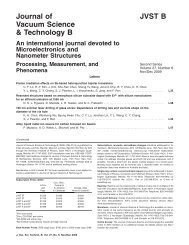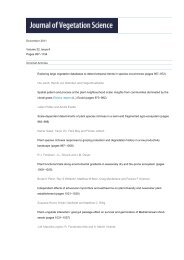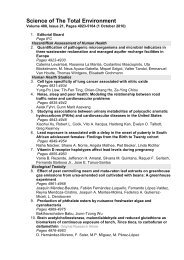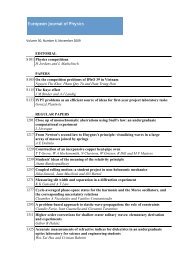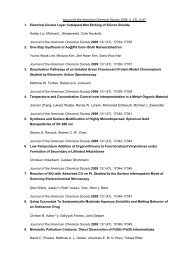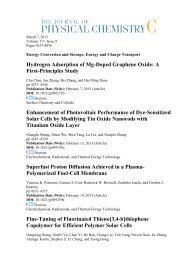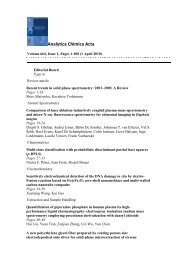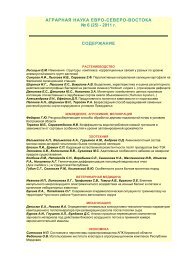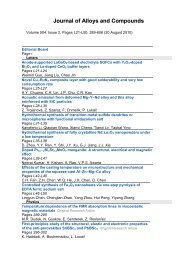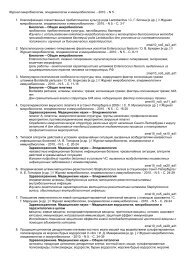Analytica Chimica Acta Volume 751, Pages 1-188 (2 November 2012)
Analytica Chimica Acta Volume 751, Pages 1-188 (2 November 2012)
Analytica Chimica Acta Volume 751, Pages 1-188 (2 November 2012)
Create successful ePaper yourself
Turn your PDF publications into a flip-book with our unique Google optimized e-Paper software.
Editorial Board<br />
Page iii<br />
Review articles<br />
<strong>Analytica</strong> <strong>Chimica</strong> <strong>Acta</strong><br />
<strong>Volume</strong> <strong>751</strong>, <strong>Pages</strong> 1-<strong>188</strong> (2 <strong>November</strong> <strong>2012</strong>)<br />
Fluorescent nanoparticles for intracellular sensing: A review<br />
Review Article<br />
<strong>Pages</strong> 1-23<br />
Maria J. Ruedas-Rama, Jamie D. Walters, Angel Orte, Elizabeth A.H. Hall<br />
Graphical abstract<br />
Highlights<br />
► <strong>Analytica</strong>l applications of fluorescent nanoparticles (NPs) in intracellular sensing. ► Critical<br />
review on performance of QDots, metal NPs, silica NPs, and polymer NPs. ► Highlighted potential of<br />
fluorescence lifetime imaging microscopy (FLIM).<br />
Sensing colorimetric approaches based on gold and silver nanoparticles<br />
aggregation: Chemical creativity behind the assay. A review<br />
Review Article<br />
<strong>Pages</strong> 24-43<br />
Diana Vilela, María Cristina González, Alberto Escarpa<br />
Graphical abstract
Highlights<br />
► Visual detection based gold and silver nanoparticles aggregation. ► Functionalized and nonfunctionalized<br />
nanoparticles. ► High selectivity and sensitivity. ► No complex instrumentation is<br />
required/chemical creativity for analyte detection.<br />
Chemometrics<br />
Validation of analytical methods involved in dissolution assays:<br />
Acceptance limits and decision methodologies<br />
Original Research Article<br />
<strong>Pages</strong> 44-51<br />
E. Rozet, E. Ziemons, R.D. Marini, B. Boulanger, Ph. Hubert<br />
Graphical abstract<br />
Highlights<br />
► Novel methodology to validate analytical methods involved in dissolution tests. ► Valid methods<br />
will ensure to make the correct decisions with high probability. ► A Quality by Design compliant<br />
validation methodology for dissolution assays. ► <strong>Analytica</strong>l Target Profile is defined for dissolution<br />
assays. ► Application to the validation of a HPLC–UV analytical method.<br />
Electrochemistry<br />
Nanoplatinum-enclosed gold nanocores as catalytically promoted<br />
nanolabels for sensitive electrochemical immunoassay
Original Research Article<br />
<strong>Pages</strong> 52-58<br />
Jun Zhou, Dianping Tang, Li Hou, Yuling Cui, Huafeng Chen, Guonan Chen<br />
Graphical abstract<br />
Highlights<br />
► We report a new sandwich-type electrochemical immunoassay of biomarkers. ► Nanoplatinumenclosed<br />
gold nanocores as catalytically promoted nanolabels. ► Dual amplification of electrochemical<br />
signal. ► The catalytic reaction of the products.<br />
Poly(methylene blue) functionalized graphene modified carbon ionic<br />
liquid electrode for the electrochemical detection of dopamine<br />
Original Research Article<br />
<strong>Pages</strong> 59-65<br />
Wei Sun, Yuhua Wang, Yuanyuan Zhang, Xiaomei Ju, Guangjiu Li, Zhenfan Sun<br />
Graphical abstract<br />
Highlights<br />
► Poly(methylene blue) functionalized graphene was electrodeposited on the electrode. ► The<br />
fabricated electrode showed better electrochemical performances. ► Dopamine was sensitive detected<br />
by the modified electrode.<br />
Voltammetric detection of the α-dicarbonyl compound: Methylglyoxal as<br />
a flavoring agent in wine and beer<br />
Original Research Article<br />
<strong>Pages</strong> 66-70
Sanghamitra Chatterjee, Aicheng Chen<br />
Graphical abstract<br />
Highlights<br />
► Synergistic electrocatalytic effect of Pt nanoparticles and single-wall carbon nanotubes on the<br />
reduction of methylglyoxal. ► Novel electrochemical Pt/SWNT/GCE sensor designed for the<br />
determination of methylglyoxal. ► Excellent analytical performance with low detection limit and high<br />
sensitivity. ► The developed methylglyoxal sensor shows promising process control, clinical and,<br />
biomedical applications.<br />
Extraction and Sample Handling<br />
Liquid–liquid–solid microextraction and detection of nerve agent<br />
simulants by on-membrane Fourier transform infrared spectroscopy<br />
Original Research Article<br />
<strong>Pages</strong> 71-78<br />
Prabhat Garg, Ajay Purohit, Vijay K. Tak, Ajeet Kumar, D.K. Dubey<br />
Graphical abstract<br />
Highlights<br />
► A novel liquid–liquid–solid microextraction technique has been optimised. ► Markers of CWA<br />
have been detected by FTIR spectroscopy avoiding elution step. ► A chemometric PLS approach has<br />
been applied for the quantitation of mixture. ► Developed method was validated using unknown<br />
sample of official proficiency test.<br />
Emulsification liquid phase microextraction followed by on-line phase
separation coupled to high performance liquid chromatography<br />
Original Research Article<br />
<strong>Pages</strong> 79-85<br />
Behnam Ebrahimpour, Yadollah Yamini, Ali Esrafili<br />
Graphical abstract<br />
Highlights<br />
► A new on-line emulsification liquid phase microextraction coupled HPLC is introduced. ► The<br />
dispersed organic solvent was separated from water sample using in-line filter. ► Filter was located in<br />
injection position and the analytes were transferred to HPLC. ► It was applied for extraction and<br />
determination of trace amounts of some parabens. ► PFs and LODs were obtained in the ranges of<br />
289–595 and 0.05–0.2 μg L −1 .<br />
New needle packed with polydimethylsiloxane having a micro-bore<br />
tunnel for headspace in-needle microextraction of aroma components of<br />
citrus oils<br />
Original Research Article<br />
<strong>Pages</strong> 86-93<br />
Hyun-Hwa Son, Sunyoung Bae, Dong-Sun Lee<br />
Graphical abstract
Highlights<br />
► We demonstrate the first in-needle microextraction using a needle packed polydimethylsiloxane<br />
having a micro-bore tunnel. ► This new method was theoretically and experimentally evaluated. ► The<br />
extraction parameters have been optimized along with the validation of method performance. ► It was<br />
successfully applied for the analysis of aroma components emitted from citrus essential oils.<br />
Mass Spectrometry<br />
A method to detect metal–drug complexes and their interactions with<br />
pathogenic bacteria via graphene nanosheet assist laser<br />
desorption/ionization mass spectrometry and biosensors<br />
Original Research Article<br />
<strong>Pages</strong> 94-104<br />
Hani Nasser Abdelhamid, Hui-Fen Wu<br />
Graphical abstract<br />
Highlights<br />
► Probe transition metals-complexes based on noncovalent functionalized graphene for MALDI-MS.<br />
► Study interaction of transition metals complexes with pathogenic bacteria. ► Propose a new<br />
biosensor for two pathogenic bacteria.<br />
Molecular Spectrometry<br />
A set of triple-resonance nuclear magnetic resonance experiments for<br />
structural characterization of organophosphorus compounds in<br />
mixture samples<br />
Original Research Article<br />
<strong>Pages</strong> 105-111<br />
Harri Koskela<br />
Graphical abstract
Highlights<br />
► New 1 H, 13 C, 31 P triple-resonance NMR pulse experiments. ► Analysis of organophosphorus (OP)<br />
compounds in complex matrix. ► Selective extraction of 1 H, 31 P, and 13 C chemical shifts and<br />
connectivities. ► More precise NMR identification of OP nerve agents and their degradation products.<br />
Rapid, on-site identification of explosives in nanoliter droplets using a<br />
UV reflected fiber optic sensor<br />
Original Research Article<br />
<strong>Pages</strong> 112-118<br />
Xin Li, Qiang Li, Hong Zhou, Hongxia Hao, Tongzhou Wang, Songmin Zhao, Ying Lu, Guoliang<br />
Huang<br />
Graphical abstract<br />
Highlights<br />
► We design a portable system for the on-site detection of explosives. ► The system is capable of<br />
rapid, costless detection with low sample consumption. ► We develop a novel algorithm capable of<br />
identifying explosives. ► Seven explosives and a PETN–RDX mixture are detected and identified. ► Real<br />
world samples are identified and the results are validated by LC/MS/MS.<br />
Sensors and Bioselective Reagents<br />
A highly sensitive and selective immunoassay for the detection of
tetrabromobisphenol A in soil and sediment<br />
Original Research Article<br />
<strong>Pages</strong> 119-127<br />
Ting Xu, Jia Wang, Shang-zhong Liu, Cong Lü, Weilin L. Shelver, Qing X. Li, Ji Li<br />
Graphical abstract<br />
Highlight<br />
► The developed ELISA is highly sensitive and selective to TBBPA. ► Accuracy of this ELISA for<br />
TBBPA in environmental matrices were reasonable. ► TBBPA levels found in environmental samples<br />
showed variation. ► ELISA for TBBPA in real samples correlated well with LC–MS/MS method.<br />
A gel-based visual immunoassay for non-instrumental detection of<br />
chloramphenicol in food samples<br />
Original Research Article<br />
<strong>Pages</strong> 128-134<br />
Meng Yuan, Wei Sheng, Yan Zhang, Junping Wang, Yijin Yang, Shuguang Zhang, Irina Yu.<br />
Goryacheva, Shuo Wang<br />
Graphical abstract<br />
A fluorescence reagent for the highly selective recognition and<br />
separation of lead ion (II) from aqueous solutions<br />
Original Research Article<br />
<strong>Pages</strong> 135-139
Li-Jun Ma, Yuhua Yan, Liping Chen, Weiguang Cao, Hongwei Li, Liting Yang, Yuqing Wu<br />
Graphical abstract<br />
Highlights<br />
► A new fluorescence reagent (1) for Pb 2+ was synthesized. ► The fluorescence sensor shows a low<br />
detection limit (20.7 μg L −1 ) for Pb 2+ . ► The sensor exhibits a specific selectivity for Pb 2+ in aqueous<br />
solution. ► The reagent can remove Pb 2+ with a good reversibility from aqueous solution.<br />
Palladium@gold bimetallic nanostructures as peroxidase mimic for<br />
development of sensitive fluoroimmunoassay<br />
Original Research Article<br />
<strong>Pages</strong> 140-145<br />
Yogesh Nangia, Bipul Kumar, Jyotsna Kaushal, C. Raman Suri<br />
Graphical abstract<br />
Highlights<br />
► Peroxidase like property of palladium–gold bimetallic nanostructures has been demonstrated. ►<br />
Pd@AuNS based fluoro-immunoassay using fluorogenic peroxidase substrate is developed. ► High<br />
sensitivity for fluoro-immunoassay (IC50 ∼ 1.55 ng mL −1 ) for bensulfuron detection. ► Pd@AuNS can be<br />
readily used for the detection of H2O2 for various applications.
Multiplex detection platform for tumor markers and glucose in serum<br />
based on a microfluidic microparticle array<br />
Original Research Article<br />
<strong>Pages</strong> 146-154<br />
Qingdi Zhu, Dieter Trau<br />
Graphical abstract<br />
Highlights<br />
► Microparticle array on gel microstructures which can sustain microfluidic flow. ► Quantitative<br />
microfluidic microbead-based immunoassay for serum tumor marker. ► Quantitative microfluidic<br />
microparticle-based enzymatic assay for serum glucose. ► Multiplexed immunoassay for tumor markers<br />
with spatially encoded microbead array. ► Simultaneous immune- and enzymatic assays with<br />
microfluidic microparticle arrays.<br />
Droplet-based microscale colorimetric biosensor for multiplexed DNA<br />
analysis via a graphene nanoprobe<br />
Original Research Article<br />
<strong>Pages</strong> 155-160<br />
Xia Xiang, Ming Luo, Liyang Shi, Xinghu Ji, Zhike He<br />
Graphical abstract
Highlights<br />
► A quantitative detection for multiplexed DNA is first realized on droplet platform. ► The DNA<br />
detection is relied on a simple fluorescence-based colorimetric method. ► GO is served as a quencher<br />
for two different DNA fluorescent probes. ► This present work provides a rapid, sensitive, visual and<br />
convenient detection tool for droplet biosensor.<br />
Towards an integrated biosensor array for simultaneous and rapid<br />
multi-analysis of endocrine disrupting chemicals<br />
Original Research Article<br />
<strong>Pages</strong> 161-170<br />
Viviana Scognamiglio, Italo Pezzotti, Gianni Pezzotti, Juan Cano, Ivano Manfredonia, Katia<br />
Buonasera, Fabiana Arduini, Danila Moscone, Giuseppe Palleschi, Maria Teresa Giardi<br />
Graphical abstract<br />
Highlights<br />
► A multitask biosensor for the detection of endocrine disrupting chemicals is proposed. ► The<br />
sensing system employ an array of biological recognition elements. ► Amperometric and optical<br />
transduction methods are provided in an integrated biosensor together with flow control systems. ►<br />
The biosensing device results in an integrated, automatic and portable system for environmental and<br />
agrifood application.<br />
An acyclic, dansyl based colorimetric and fluorescent chemosensor for<br />
Hg(II) via twisted intramolecular charge transfer (TICT)<br />
Original Research Article<br />
<strong>Pages</strong> 171-175<br />
Vairaperumal Tharmaraj, Kasi Pitchumani<br />
Graphical abstract
Highlights<br />
► A highly selective, simple, acyclic, dansyl based bipodal on–off fluorescence chemosensor for Hg 2+<br />
ion is reported. ► The system exhibits visible color change from colorless to gray upon Hg 2+ binding via<br />
TICT mechanism. ► Hg 2+ -ion detection limit (as low as 5.0 × 10 −10 mol L −1 ) is reported. ► This system<br />
can also be applied in real samples.<br />
Separation Methods<br />
Analysis of cytokinin nucleotides by capillary zone electrophoresis with<br />
diode array and mass spectrometric detection in a recombinant enzyme<br />
in vitro reaction<br />
Original Research Article<br />
<strong>Pages</strong> 176-181<br />
Tibor Béres, Markéta Gemrotová, Petr Tarkowski, Markus Ganzera, Vítězslav Maier, David<br />
Friedecký, Marco A. Dessoy, Ludger A. Wessjohann, Lukáš Spíchal, Miroslav Strnad, Karel<br />
Doležal<br />
Graphical abstract<br />
Highlight<br />
► We describe a capillary electrophoresis based enzymatic assay. ► Cytokinin mono-, di- and<br />
triphosphates were separated by CE for the first time. ► The products of enzymatic reactions were<br />
unambigously identified by HPLC-QqTOF-MS. ► Undesirable changes in substrates/products were<br />
observed.<br />
Effectiveness of in-needle extraction device for liquid samples<br />
Original Research Article<br />
<strong>Pages</strong> 182-<strong>188</strong><br />
Monika Pietrzyńska, Adam Voelkel, Károly Héberger, Katarzyna Bielicka-Daszkiewicz, Mariusz<br />
Kaczmarek<br />
Graphical abstract
Highlights<br />
► Modeling of functioning for in-needle extraction device. ► Selection of working conditions for<br />
prediction of liquid flow velocity. ► New PIN parameter indicates the efficient working conditions.



